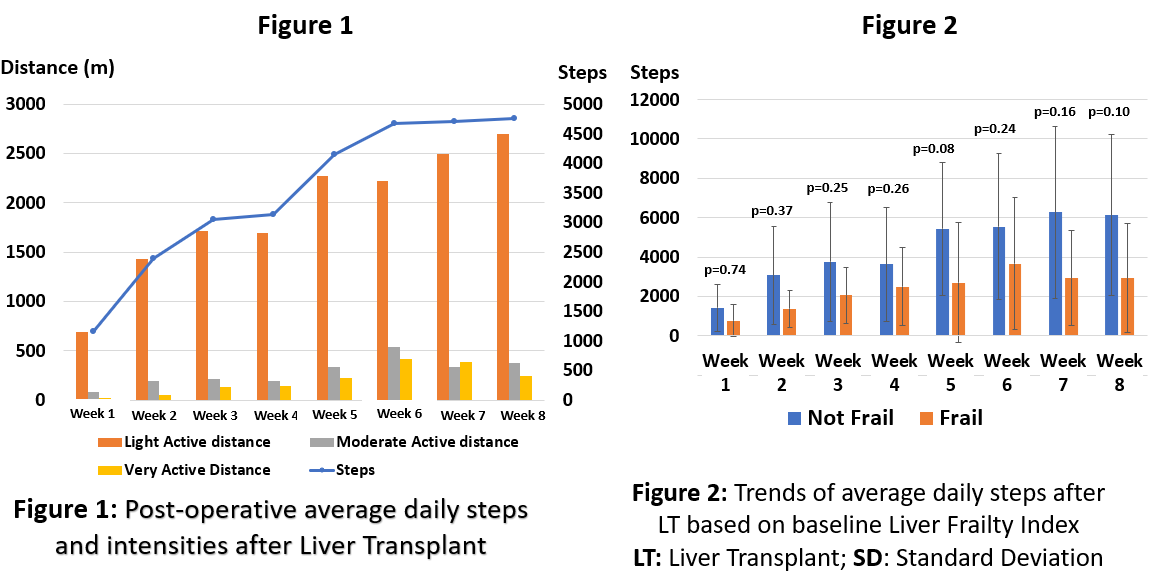Measurement of Physical Activity and Frailty in the Early Post-Operative Period After Liver Transplant Surgery: Single-Center Pilot Study Using Fitbit Watch
Henry Ford Transplant Institute, Detroit, MI
Meeting: 2022 American Transplant Congress
Abstract number: 426
Keywords: Liver transplantation, Monitoring, Morbidity, Surgery
Topic: Clinical Science » Liver » 55 - Liver: Recipient Selection
Session Information
Session Name: Recipient Selection
Session Type: Rapid Fire Oral Abstract
Date: Tuesday, June 7, 2022
Session Time: 3:30pm-5:00pm
 Presentation Time: 4:50pm-5:00pm
Presentation Time: 4:50pm-5:00pm
Location: Hynes Room 312
*Purpose: Robust physical activity after liver transplant (LT) is an important determinant of long-term health. Patient and providers assessments of perioperative physical activity do not reliably indicate actual performance. This pilot study aimed to evaluate the utility of a physical activity monitor (PAM) in tracking postoperative biophysical data after LT.
*Methods: 41 adult LT candidates were enrolled since February 2021. LT candidates were excluded if they underwent multi-organ transplant, were intubated, had severe hepatic encephalopathy prior to transplant. Liver Frailty Index (LFI) was performed in the pre-and post-operative period. All patients were provided with a PAM (Fitbit® Inspire 2 watch) and were instructed to wear it continuously for 30-60 postoperative days (POD). Biophysical data obtained from PAM included: daily steps and exercise intensity duration/distance.
*Results: 24 patients with complete frailty and PAM data were included in the final cohort with baseline characteristics described in Table 1. The mean daily steps during the LT admission, POD 1-30 days, and POD 30-60 were 963 steps (Standard Deviation [SD] 877; n=24), 2584 (SD:2052; n=24), and 4477 steps (SD:3437; n=15) respectively (Figure 1). The number of steps during the first 30 days after surgery and POD 30-60 correlated negatively with increasing age (POD 1-30: r -0.57, p=0.003; POD 30-60: r -0.59, p=0.021) and longer hospital length of stay (POD 1-30: r -0.49, p=0.015; POD 30-60: r -0.59, p=0.022). Patients who were “frail” at baseline (per LFI; n=9) had a trend towards lower steps compared to “non-frail” (n=14) patients (Mean steps [SD]: 4408 [1605] vs. 2365 [872] respectively; p=0.08) (Figure 2).
*Conclusions: This is the first study to demonstrate the utility of a PAM for tracking a patient’s physical activity after LT. The post-operative data from the PAM can be used as an objective measure to guide early aggressive physical therapy to allow patients to return to their baseline physical activity.
To cite this abstract in AMA style:
Shamaa T, Allenspach L, Shamaa O, Shimada S, Crombez C, Hage-Hassan O, Kitajima T, Yeddula S, Bajjoka I, Collins K, Rizzari M, Yoshida A, Abouljoud M, Nagai S. Measurement of Physical Activity and Frailty in the Early Post-Operative Period After Liver Transplant Surgery: Single-Center Pilot Study Using Fitbit Watch [abstract]. Am J Transplant. 2022; 22 (suppl 3). https://atcmeetingabstracts.com/abstract/measurement-of-physical-activity-and-frailty-in-the-early-post-operative-period-after-liver-transplant-surgery-single-center-pilot-study-using-fitbit-watch/. Accessed December 13, 2025.« Back to 2022 American Transplant Congress

